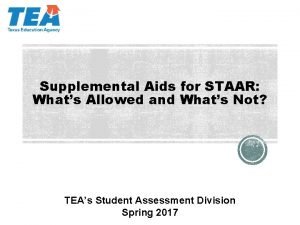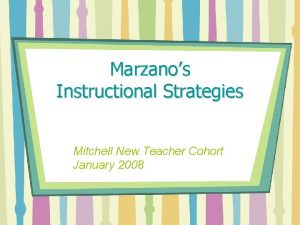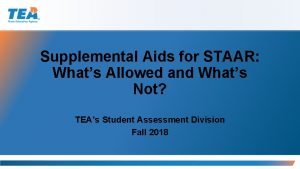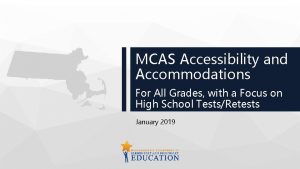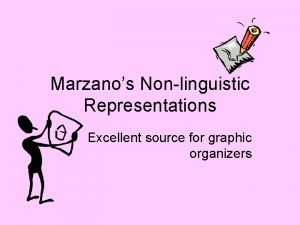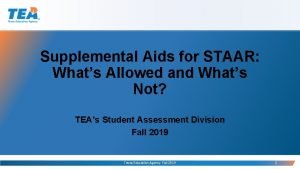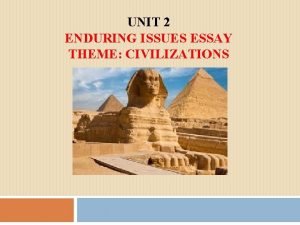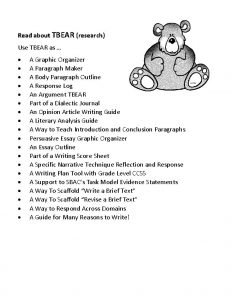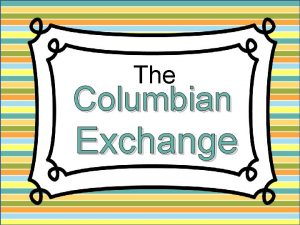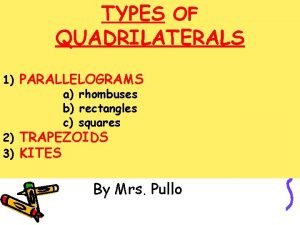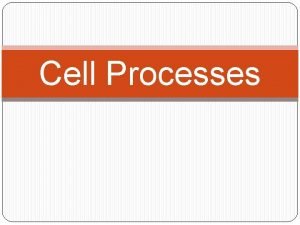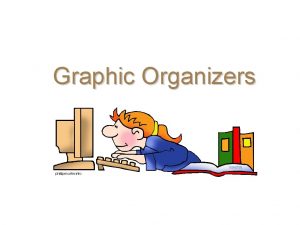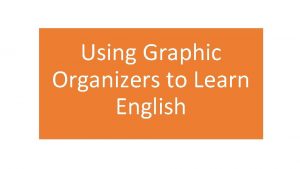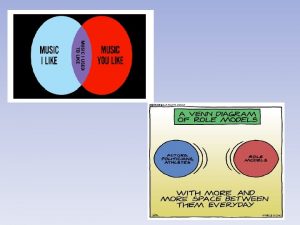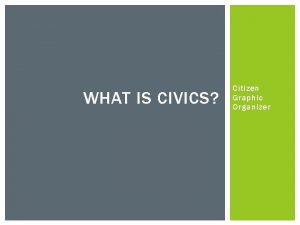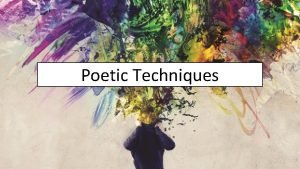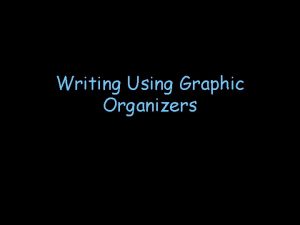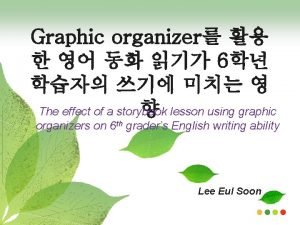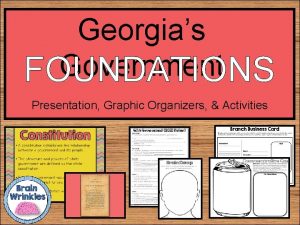Poetic Foundations Use with 3 Graphic Organizers Organizer


















- Slides: 18

Poetic Foundations Use with 3 Graphic Organizers

Organizer 1: Types of Poetry Lyric: Expresses Feelings (songs, etc. ) Elegy – poem about death or loss Ode – dedication poem Sonnet – 14 line poem, often about love Haiku – Japanese style poem, three lines (5 -7 -5 syllables), typically about nature An old silent pond. . . (5) A frog jumps into the pond, (7) splash! Silence again. (5)

Types of Poetry Narrative – tells a story Ballad – plot-driven song-like poem with characters and conflict Epic – Long narrative poem recounting the adventures of a hero

Lines and Stanzas Lines of poetry: As opposed to sentences in prose A group of words arranged in a row Read lines of poetry like a paragraph on the first reading: look for punctuation. If you don’t see punctuation, keep going Two types of lines: Run-on lines (this is known as enjambment) The meaning doesn’t end with the line End-stopped line (punctuation at the end)

Examples of Lines End Stopped Lines: A little learning is a dangerous thing; Drink deep, or taste not the Pierian spring. There shallow draughts intoxicate the brain, And drinking largely sobers us again. An Essay on Criticism by Alexander Pope) Run on Lines / Enjambment: It is a beauteous Evening, calm and free; The holy time is quiet as a Nun Breathless with adoration; the broad sun Is sinking down in its tranquility; It is a Beauteous Evening by William Wordsworth

Stanzas Groups of lines in poetry (versus paragraphs in prose) Various types of stanzas: 2 line stanza: Couplet 3 line stanza: Tercet 4 line stanza: Quatrain 5 line stanza: Cinquain

Stanza Examples Couplet: "Blessed are you whose worthiness gives scope Being had, to triumph; being lacked, to hope. “ Tercet: “An old silent pond. . . A frog jumps into the pond, splash! Silence again. ” Quatrain: “Tyger, tyger, burning bright In the forests of the night, What immortal hand or eye Could frame thy fearful symmetry? ”

Organizer 2: How Poets Achieve Effect Through Rhythm: Meter – the rhythm established in a poem / the pattern of stressed and unstressed syllables Foot – basic unit of measurement in a poem (either 2 or three syllables – isn’t measured in words) Perfect Rhyme – identical rhyming words (Skylight and highlight / bean and green) Internal Rhyme – rhyming within the line End Rhyme – rhyming at the end of the line Rhyme Scheme – the rhythmic pattern based on the last word in each line Iamb – a type of metric foot; 2 syllables – the first is unstressed /the second is stressed Iambic Pentameter - 5 iambic feet Blank Verse – unrhymed iambic pentameter Free Verse (Open Form) – no set rhythm

Examples of Rhythmic Devices Examples of iambic feet: Because A mouse Revealed Itself To fly Now here’s the whole line (it’s iambic pentameter): (Because) (a mouse) (revealed) (itself) (to fly). Here’s another example (scan it): “One day I wrote her name upon the sand. ”

More Rhythmic Examples Rhyme scheme:

And yet more Rhythmic Examples Blank verse from Romeo and Juliet: (this is unrhymed iambic pentameter – used to mimic natural speech or push the boundaries of conventions and form) “I thank you, honest gentlemen. Good night More torches here! Come on then, let’s to bed. ” Rhyming couplets in Shakespeare used in more formal situations: “Saints do not move, though grant for prayer’s sake. Then move not while my prayer’s effect I take. ”

Free Verse / Open Form Fog by Carl Sandburg The fog comes on little cat feet. It sits looking over harbor and city on silent haunches and then moves on.

How Poets Achieve Effect Through Sound Devices Onomatopoeia: A word that mimics its sound: splash, boom, crash, swish, whoosh Alliteration: Repetition of consonant sounds: Peter Piper Picked a Peck of Pickled Peppers Consonance: Repetition of sounds within words: "all mammals named Sam are clammy” Slant Rhyme/ Near Rhyme: Words that almost rhyme: "Rap rejects my tape deck, ejects projectile/Whether Jew or gentile I rank top percentile. “ – The Fugees Assonance: Repetition of vowel sounds: Aunt Annie ate eight apples

How Poets Achieve Effect Through Figurative Devices Hyperbole – exaggeration for effect Understatement – the presentation of something as being less than it is Simile – indirect comparison using like or as Metaphor – direct comparison without like or as Imagery – descriptive details that create a mental picture (appeals to the senses) Personification – giving human qualities to nonhuman things Oxymoron – contradictory phrase (ground pilot, the living dead) Paradox – a statement or concept that appears to be contradictory, but might real a deeper truth: The paradox that standing is more tiring than walking

Organizer 3: How to Understand Poetry Enjambment is KEY – the running on of lines Determine what the poet is treating literally and what is being treated figuratively. Ask “What is the subject? ” Possible subjects: love, children, nature, war, peace, justice, culture, racism, sports, social issues

Tone and Mood Ask “What is the speaker’s tone? ” How does the speaker feel about the subject? Tone Words: detached, cynical, optimistic, playful, dreamy, confident, inflammatory, critical What is the overall mood or ATMOSPHERE of the poem? Mood words: energetic, nightmarish, melancholy, dignified, foreboding, sentimental, suspenseful Are there SHIFTS in tone and/or mood between stanzas?

Read it SEVERAL times 1 st = Get an overview What’s the general subject? What’s the tone? 2 nd = Read for meaning What 3 rd is figurative and what is literal? = Read for deep meaning How does the poet feel about the subject? Why does she choose specific figurative devices? What do symbols stand for?

What to look for Subject Tone Mood Run-on lines/ end-stopped lines Stanzas Imagery Figurative Devices Rhythm Sound Devices Shifts
 Grammar and mechanics rules for staar 2021
Grammar and mechanics rules for staar 2021 Hierarchy
Hierarchy Marzano graphic organizers
Marzano graphic organizers Tea supplemental aids
Tea supplemental aids Dese mcas accommodations
Dese mcas accommodations Mcas graphic organizers
Mcas graphic organizers Tea blank graphic organizers
Tea blank graphic organizers Time sequence pattern organizer
Time sequence pattern organizer Math supplemental aids
Math supplemental aids Enduring issues essay outline
Enduring issues essay outline Tbear graphic organizer
Tbear graphic organizer Columbian exchange poem
Columbian exchange poem Cohens vs virginia apush
Cohens vs virginia apush Graphic organizer of quadrilaterals
Graphic organizer of quadrilaterals Cell graphic organizer
Cell graphic organizer What is the organized sequence of events called in a story?
What is the organized sequence of events called in a story? Cell transport graphic organizer answers
Cell transport graphic organizer answers Handout 5-2 graphic organizer the brain answers
Handout 5-2 graphic organizer the brain answers Environmental issues cloze notes 1 answer key
Environmental issues cloze notes 1 answer key
